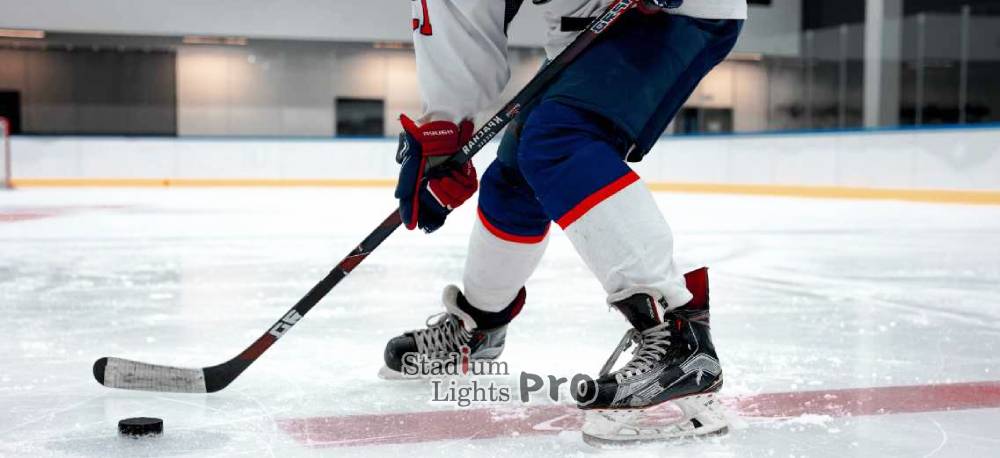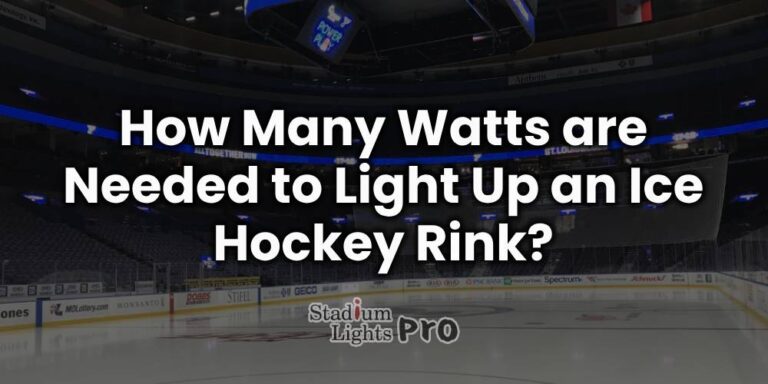
Ice Hockey Rink Lighting
Lighting in ice hockey rinks shapes not only the atmosphere but also the functionality of the space. The surface of the ice reflects light differently than other sports surfaces, which creates specific challenges for visibility and contrast. Rinks must maintain consistent lighting to enhance player performance, support referees in making accurate calls, and offer a clear view for spectators.
Beyond visibility, lighting adds to the visual appeal of the game. It creates drama, highlights the sleek movement on the ice, and enhances the energy inside the arena. Whether for a neighborhood facility or a professional venue, the role of lighting extends beyond utility—it helps define the character of the game and the venue.

Contact us for a free lighting consultation
Table of Contents
ToggleCommon Lighting Technologies in Use
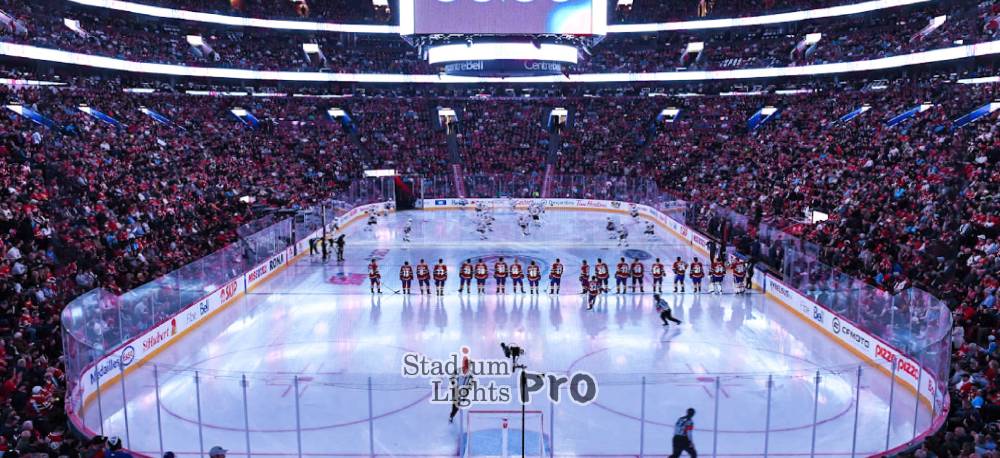
Metal Halide Systems
Metal halide fixtures were long considered a standard for indoor sports lighting, including hockey. These lights produce high-intensity output and cover large areas effectively. Their color rendering and brightness meet many performance needs, but they do come with drawbacks. The warm-up time is lengthy, and once turned off, they require a cooldown period before restarting. Additionally, energy consumption is on the higher end, and lamp replacement is frequent due to shorter lifespan.LED Lighting Solutions
LED lighting has become a common upgrade in recent years. These systems offer a wide range of benefits, such as longer operational life, minimal warm-up times, and lower energy consumption. LEDs can also be configured for dynamic controls, allowing arena operators to adjust brightness, direction, and even colors for pre-game shows or intermissions. They provide a uniform light field that reduces shadows and helps cameras maintain better clarity during fast motion.Fluorescent and Legacy Fixtures
Some older or smaller facilities still rely on fluorescent lighting or older incandescent fixtures. While functional, these options often fall short in delivering the uniformity and brightness expected in modern rinks. Their inefficiency and maintenance demands often drive rink managers to consider replacements as funding allows.Design Priorities in Ice Rink Lighting
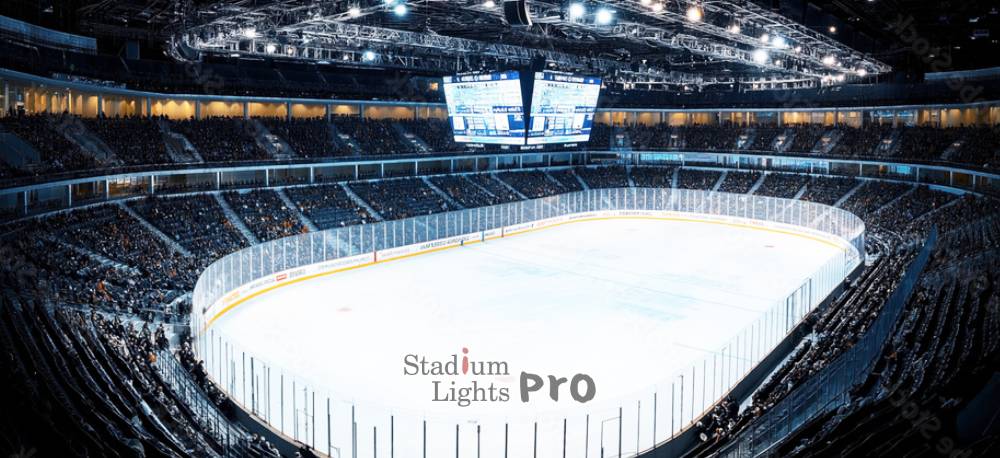
| Rink Use | Recommended Lux Levels | Purpose and Considerations |
|---|---|---|
| Recreational and Training Environments | 300 – 500 lux | Provides adequate light for safe movement and casual games. Prioritizes comfort and energy savings over high performance. Broad beam angles and wider fixture spacing are used to ensure general coverage. |
| Competitive Match and League Play | 800 – 1000 lux | Increases game visibility for fast-paced play, accurate puck tracking, and enhanced spatial awareness for coaches and referees. Requires consistent lighting across the rink with no shadows or variations in brightness. |
| Professional and Broadcasted Events | 1200 – 1500 lux | Supports high-quality broadcast, ensuring clarity under high-speed motion and various camera angles. Prevents glare and lens flare, with specialized broadcast optics and low flicker rates to maintain visual fidelity. |
Recommended Lux Levels for Various Rink Uses
Lux levels measure the amount of luminous flux per unit area and are a foundational aspect of lighting design for ice rinks. Because ice is both reflective and expansive, the quantity and quality of light play a vital role in how well the game is seen and played. Lighting requirements vary depending on the purpose of the rink, ranging from casual skating to professional broadcasts. Understanding how to tailor lux levels to each situation ensures that players and spectators get the most from the facility.Lux Levels for Recreational and Training Environments
Recreational rinks or those used primarily for training do not need the same degree of intensity found in competitive arenas. These environments benefit from moderate lux levels, typically between 300 and 500 lux. This range offers enough light for skaters to move safely, coaches to observe player movement, and casual games to proceed without visual strain. At this level, energy consumption is lower, making it a cost-effective solution for facilities where high-end performance is not a priority. These settings often prioritize comfort and energy savings over elite visibility. Lighting solutions in these cases may rely on broader beam angles and wider spacing, ensuring general coverage rather than precision targeting. While color quality and uniformity are still relevant, they are balanced against affordability and operating hours.Competitive Match and League Play Requirements
Rinks designed for league matches, tournaments, and semi-professional play require higher lux levels—typically ranging from 800 to 1000 lux. In this setting, the pace of the game increases and accurate puck tracking becomes vital. Fast transitions, precise puck handling, and long-distance passes demand that the entire surface be clearly visible without shadows or variation in brightness. Increased lux levels in competitive settings also support coaches, referees, and scorekeepers by enhancing depth perception and spatial awareness. The lighting must support both horizontal and vertical movement while making sure players remain distinguishable from the background and each other, regardless of where they are on the rink.Lighting for Professional and Broadcasted Events
For televised games and professional-level tournaments, lux levels must often reach between 1200 and 1500 lux. These elevated values are not solely for gameplay but also for ensuring high-quality image capture. Broadcast lighting must maintain clarity under high-speed motion and variable camera angles, all while preventing glare or lens flare. These rinks must also meet strict lighting guidelines provided by broadcasters and sports federations. Cameras need consistent brightness and color rendering across every inch of the ice. Shadows or areas with poor lighting can create visual artifacts on screen and reduce the quality of the broadcast. Lighting designers use advanced simulation software to model glare control, lux uniformity, and fixture behavior before the installation phase. In many cases, specialized fixtures with broadcast-rated optics and low flicker rates are selected to maintain visual fidelity.Even Distribution Across the Ice
Uniform lighting across the entire surface is a foundational element in ice rink design. A well-lit rink ensures that players can maintain spatial awareness, accurately judge distances, and stay engaged with the game flow. Inconsistencies in brightness or dark patches across the ice can lead to missed passes, misjudged puck movement, or delayed reactions. For referees, consistent light helps with interpreting plays and enforcing rules with greater precision. The lighting grid must be carefully engineered, with fixtures placed and angled to deliver balanced coverage from one end of the rink to the other. Mounting height, beam angle, and luminaire type must be selected to reduce vertical shadows and avoid excessive brightness in localized areas. This configuration allows for a seamless playing experience where lighting becomes a supportive background element rather than a distraction.Color Quality and Temperature
The visual appearance of the ice and surroundings is strongly influenced by color temperature. Lights that produce a color temperature in the 5000K to 6000K range generally produce a clean, white light that closely resembles daylight. This spectrum brings out the crisp contrast between white ice, black pucks, and colored jerseys, improving the clarity of fast-paced gameplay for both players and spectators. Color rendering index (CRI) also plays a role in perception. Higher CRI values, closer to 90 or above, allow more accurate differentiation of colors. This is particularly helpful in televised games and during moments of visual congestion when player movement is dense. Poor color balance or lighting that’s overly warm or cold in tone can make it harder to identify players and puck location, especially in peripheral areas of the ice.Managing Reflections on the Ice
The unique nature of ice as a reflective surface adds an extra layer of complexity to rink lighting design. Smooth, polished ice can create mirrored reflections and glare if lighting is not properly managed. These glare points can distort player vision and reduce depth perception, especially in fast transitions or when tracking the puck along the boards. Reducing glare involves selecting light fixtures with precise beam control and careful aiming. Indirect lighting techniques, such as bouncing light off ceilings or walls, can also minimize the chance of harsh reflections. Some setups utilize diffusers to soften the light before it reaches the ice surface, spreading it more evenly and reducing sharp, concentrated points of brightness.Choosing Lights with the Right Temperature to Protect Ice Integrity
Color temperature plays a major role in how lighting looks on the ice, but it also relates directly to the physical impact of lighting systems on ice maintenance. Ice is a delicate surface that relies on stable temperatures to perform consistently. When lighting systems emit heat, especially over long durations or at high intensities, the surface can begin to soften, leading to uneven skating conditions, higher energy costs, and increased wear on refrigeration systems.Why Ice Temperature Stability Matters
A high-performing ice surface depends on keeping the temperature within a narrow range. Even minor variations caused by radiant heat from lighting can degrade surface quality. Softer patches can develop where heat is concentrated, leading to inconsistent puck behavior, disrupted skating rhythm, and even player safety concerns. Softer ice absorbs more energy from skates, slowing movement and increasing fatigue. Maintaining temperature integrity is also essential for long events, where lighting remains on for hours.Infrared Radiation and Its Effects
Traditional lighting systems, such as halogen and metal halide fixtures, release large amounts of infrared radiation. This invisible heat energy travels in direct lines and warms surfaces it contacts—including the ice. When multiple high-heat fixtures are mounted above the rink, their cumulative output increases the load on cooling systems, requiring compressors to work harder and consume more power to preserve ice quality. This increased energy demand leads to higher operational costs and accelerates wear on refrigeration components. Over time, this can result in the need for more frequent maintenance and potentially shorten the life span of rink equipment.LED Fixtures Minimize Radiant Heat
LED technology has become a preferred solution for ice rinks due to its low radiant heat profile. Unlike older systems, LEDs convert most of their energy into visible light rather than heat. This reduces their thermal footprint and allows them to be operated for long periods without affecting surface temperature. High-efficiency LED fixtures can also be tuned to specific color temperatures, generally between 5000K and 6000K. This range delivers bright, clear light that supports player visibility while staying close to natural daylight in tone. It also ensures that the rink maintains consistent appearance for spectators and video capture without radiating excess heat downward.Thermal Management in Fixture Design
Well-designed LED luminaires include built-in thermal management features that help dissipate residual heat. These include heat sinks, airflow channels, and insulated housings that prevent any warmth generated by the fixture from traveling toward the ice. By isolating the light-producing components from heat-sensitive areas, manufacturers ensure that lighting systems can perform efficiently in cold environments without contributing to surface instability. Some fixtures also incorporate active cooling systems, like miniature fans or phase-change materials, which regulate internal temperatures. This extra layer of control prevents performance degradation over time and contributes to the long-term success of rink lighting strategies.Fixture Positioning and Directional Control
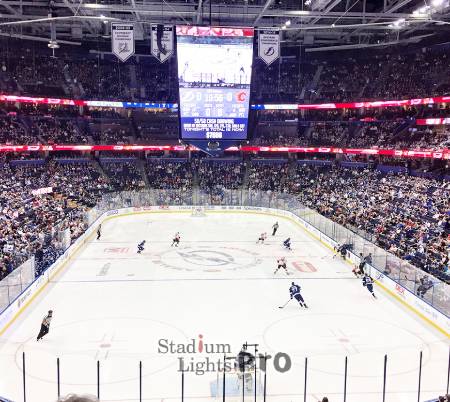 Heat impact isn’t just about fixture type—it also depends on where the lights are placed and how they are aimed. Even a low-heat fixture can contribute to surface warming if it’s positioned too close to the ice or pointed directly downward. Elevating fixtures and angling them properly distributes light more evenly while reducing the intensity of any residual heat reaching the ice.
Directional optics are often used to narrow the beam spread and focus light only where it’s needed. This approach not only enhances visual clarity but also avoids excess energy being directed toward the rink surface. The more precisely light is delivered, the less risk there is of unwanted warming or glare.
Heat impact isn’t just about fixture type—it also depends on where the lights are placed and how they are aimed. Even a low-heat fixture can contribute to surface warming if it’s positioned too close to the ice or pointed directly downward. Elevating fixtures and angling them properly distributes light more evenly while reducing the intensity of any residual heat reaching the ice.
Directional optics are often used to narrow the beam spread and focus light only where it’s needed. This approach not only enhances visual clarity but also avoids excess energy being directed toward the rink surface. The more precisely light is delivered, the less risk there is of unwanted warming or glare.
Ice Surface Longevity and Refrigeration Efficiency
Protecting the ice from unnecessary heat does more than preserve gameplay quality—it extends the lifespan of the entire rink infrastructure. When lighting systems are optimized to limit heat output, refrigeration systems don’t have to compensate for added thermal load. This reduces energy usage and minimizes the strain on chillers, pipes, and surface systems, all of which are critical to rink operation. Less frequent cycling of compressors and fewer fluctuations in ice temperature contribute to smoother performance, fewer shutdowns for repairs, and overall lower utility costs. Over the long run, this adds up to substantial savings while preserving ideal skating and game conditions.Directional Control and Beam Shaping
Beyond the type of fixture, how the light is delivered matters just as much. Fixtures with poorly controlled beam patterns can scatter light and heat inefficiently, with some of that energy reaching the ice directly and warming it over time. Modern LED luminaires designed for sports settings often include optics that focus light downward in a narrow, controlled beam while diffusing excess brightness that would otherwise contribute to heat concentration. Using precision optics and beam shaping allows lighting designers to deliver just the right amount of light to specific zones of the rink without flooding the surface with thermal energy. This level of control is especially useful in indoor arenas where airflow is limited, and heat can build up more easily above the ice.Illumination Standards and Guidance
